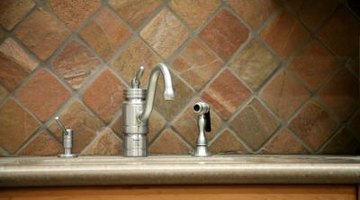How to Make a Bullnose in a Formica Countertop
Adding a bullnose edge gives a countertop a detailed, customized curve appeal, instead of a countertop edge that’s flat and ordinary. There are two ways to go about adding a bullnose strip -- you can add it to an existing Formica countertop or as a planned edging treatment in a new installation.
Preparation

Step 1
Examine the condition of the existing Formica countertop if applicable. As long as the surface is smooth and free of imperfections, you can install the bullnose edge right on top.
Step 2
Measure the length of the countertop's front edge and sides, if applicable, to determine how much bullnose tile you will need.
Step 3
Add 20 percent to the measurement noted in Step 2 to make sure you purchase enough. For example, if the length is 5 feet, purchase 6 feet of bullnose tile.
Bullnose on Existing Formica
Step 1
Do a dry run to map out the placement of the bullnose tile. Start in the middle and fill in tiles to complete the left and right sides. Make adjustments in how the tiles are spaced until the layout is satisfactory.
Step 2
Take a pen and mark lines along the left and right edges of each tile as a placement guide. Mark the overhang of the last tiles on the far left and right if necessary and cut them, according to the markings, with a wet saw. Allow cut tiles at least eight hours to dry. Otherwise, the glue will not adhere properly. You can lay these tiles last.
Step 3
Measure the height of the bullnose tile section that will rest on top of the Formica surface. Divide the measurement in half. For example, if the height of the bullnose tile is 2 inches, make a mark that is 1 inch from the edge of the countertop.
Step 4
Draw a horizontal line on the Formica surface, according to your measurement noted in Step 3. This area will serve as your sanding and gluing guide. Sand the area and use a blow dryer to remove any residue. The roughened surface will help the glue adhere.
Step 5
Apply contact cement to the sanded area for one tile at a time. Then apply glue to the back of the bullnose tile piece, up to about 1/2-inch from the edge.
Step 6
Lay the tile in place on the Formica, following your guide lines. Repeat for each tile. When the end tiles are dry, install them on the Formica to complete your installation.
Bullnose on New Formica Installation
Step 1
Place a bullnose tile strip flush against the edge of the countertop. Lay a sample piece of the Formica on the particleboard substrate, flush against the bullnose strip. Check the height of the Formica compared to the bullnose.
Step 2
Determine whether you need to add a plywood piece so the heights of both materials are even. Use a piece of A- or B-grade interior plywood at the appropriate thickness if necessary. Cut the plywood so that it only covers the area where the Formica will be laid, by deducting the height dimension for the bullnose tile from your measurements.
Step 3
Install the bullnose strips first. Follow all of the steps for installing bullnose tile in Section 2 above.
Step 4
Lay the plywood piece in place. Check to see if you need to make any adjustments and, if so, make the applicable cuts to the plywood and the Formica piece.
Step 5
Glue the plywood piece to the particleboard with contact cement. Allow for drying time, according to the directions for the contact cement. Once it is dry, glue down the Formica to complete your installation project.
References
Tips
- If your existing Formica is in good shape, you’ll save time and money because you only need to add the bullnose tile, and it will stand out as a distinctive raised border treatment. On the other hand, if you’re starting fresh, you can create a smooth transition. Instead of the bullnose being a bit taller, the Formica and the bullnose will have the same height.
Writer Bio
Cheryl Munson has been writing since 1990, with experience as a writer and creative director in the advertising industry. She holds a Bachelor of Arts in journalism with a focus on advertising from the University of Wisconsin in Madison.
Photo Credits
- Jupiterimages/Photos.com/Getty Images
More Articles



